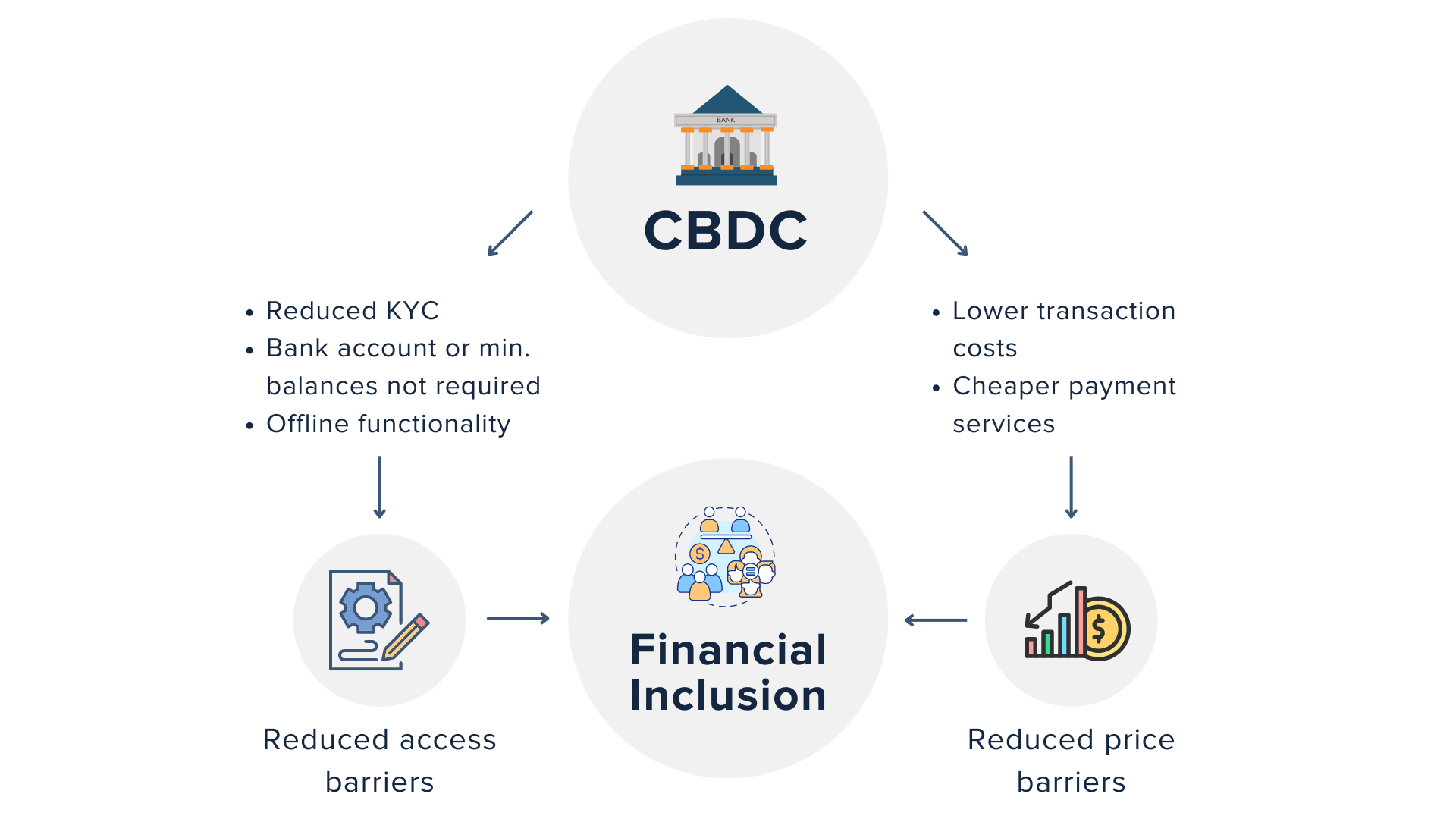
Welcome to our new blog series on “Central Bank Digital Currencies for Financial Inclusion” co-authored by Professor Heng Wang of the Yong Pung How School of Law, Singapore Management University.
In this series, we delve into the world of central bank digital currencies (CBDCs) and their potentially profound implications for financial inclusion. What are CBDCs? CBDCs are digital versions of countries’ official currencies issued by the central bank or the like. They could be the digital representation of physical cash. To date, over 110 central banks around the world are engaged in some form of CBDC-related work, and the Eastern Caribbean Central Bank, and the central banks in the Bahamas, Jamaica and Nigeria have already issued CBDCs.
With more and more governments exploring the potential of CBDCs, there is a greater need to engage with various aspects of this emerging topic, including design, especially given its potential to foster financial inclusion. UNDP has a long history of promoting technological and digital financial innovations that help advance financial inclusion and the SDGs more broadly. For example, its teams have worked with various countries on digital finance and infrastructure innovations enabling underserved business segments, such as MSMEs, to access more sophisticated financial services or on enabling micro-savers to become micro-investors in green infrastructure projects, or on harnessing the developments in Distributed Ledger Technologies to advance innovative financial instruments for private capital mobilization for nature. Given UNDP’s expertise and leadership in this space, UNDP’s involvement in this discussion will help better support member states as they navigate this changing landscape.
This inaugural blog serves as a foundational exploration of this emerging area of finance. It describes the challenges and opportunities of driving financial inclusion, and how CBDCs could serve as an important mechanism in ensuring that no one is excluded from financial services – or our increasingly digital economies and societies.
Stay tuned for our upcoming blogs, where we will delve deeper into specific aspects of CBDCs, such as their intentional design and practical tips to drive financial inclusion. Join us on this journey towards a more inclusive financial landscape.
Achieving financial inclusion through digital currencies
Individuals and small firms are facing challenges related to financial inclusion, including limited access to and high costs of banking services, lack of financial literacy, and informal financial practices, among other issues. Despite the progress made to address financial exclusion, these challenges persist: 18% of people around the world still lack a bank account. A significant share of micro, small and medium-sized enterprises – many of which are led by women – are unable to access funding or financing. And amid this backdrop, the annual SDG financing gap – the funding required to achieve the Sustainable Development Goals by 2030, has now increased to a yearly shortfall of US$4 trillion.
The digital divide is further exacerbating these challenges – for example, 2.6 billion people, or around one-third of the world’s population, still lack internet access. But this is not just about access. The ‘usage gap’, the population living within the footprint of mobile internet coverage but not using this potentially game-changing connectivity, is now eight times larger than the total number of those without coverage. Limited digital skills, unaffordable data and devices, concerns of safety and security, and a lack of relevant content and services hinder people from participating in our increasingly digital societies and economies. Financial inclusion is a complex and multifaceted issue – can CBDC’s contribute to addressing some of these challenges?
What are central bank digital currencies?
Unlike e-money, stablecoins, or private digital assets like Bitcoin, central bank digital currencies (CBDCs) are digital forms of national currencies (“fiat currencies”) issued by central banks. CBDCs can serve as a novel form of central bank money and function as new financial infrastructure. A CBDC can take two forms, retail CBDC (designed for broad public use in retail transactions) and wholesale CBDC (tailored for financial institutions and wholesale markets to facilitate large-value interbank transactions and settlements). In particular, retail CBDCs are used by the public and businesses for transactions and storing value. The potential use cases for CBDCs are diverse, including salary payments, taxation, and e-commerce. CBDCs can also utilize the technology of “smart contracts”, which are automatable and enforceable agreements. Smart contracts hold promise in fulfilling a wide range of functions, such as delivering public services to remote (underserved) areas and managing prepaid fund.
In terms of CBDC current development, 93% of 86 central banks surveyed around the world by the Bank for International Settlements (BIS) are engaged in some form of CBDC-related work, including the central banks of Sweden, China, and Euro area. Within the 30 respondents of the recent International Monetary Fund (IMF) survey on Sub-Saharan Africa, 23 stated that their central bank either has begun or plans to start research, experiments, or development related to CBDCs. The Bahamas, Eastern Caribbean, Jamaica, and Nigeria Central Banks have already issued retail CBDCs, but are currently facing challenges such as adoption rates. For example, the SandDollar, the Bahamas’ CBDC, represents a small fraction of the currency in circulation, with the number of registered wallets equivalent to approximately 25% of the population.
Various countries are actively exploring the potential use of CBDCs, particularly retail CBDCs, to improve financial inclusion. CBDCs, if properly designed and managed, may have the potential to enhance financial inclusion by addressing access and price barriers. In terms of improving access to financial services, CBDCs can be designed to reduce identity management requirements (particularly Know Your Customer [KYC]) in low-risk contexts. This could allow the use of digital currencies without the need for bank accounts or minimum balances and offer offline functionality to mitigate the impact of physical remoteness. In addition, by lowering transaction costs for financial services and providing cheaper payment services, CBDCs have the potential to address price impediments and make financial services more affordable for underserved populations.
Graph 1. Examples of how a CBDC can drive financial inclusion Created by Author
Potential for development
The understanding of the costs, benefits, and practicality of CBDCs helps countries to affect and prepare for the changing financial landscape. This understanding informs their decisions in developing infrastructure, improving efficiency (e.g., facilitating faster cashless payments), and meeting other user needs (e.g., reducing transactions costs, and providing digital financial services to vulnerable populations).
However, this potential comes with a caveat. While CBDCs hold promise for enhancing financial inclusion, they are still in the early stages of development and are not a panacea for financial inclusion. Other barriers to financial inclusion must not be overlooked (such as financial and digital literacy gaps). CBDCs also bring new risks and challenges. These include cybersecurity threats, identity theft, privacy concerns, cost recovery, carbon emission of infrastructure like data centres, and e-waste. Taking smart contracts as an example, it is crucial to address issues such as privacy concerns and potential technical glitches. Moreover, technical challenges (such as the risk of devices being tampered with during offline payments) shall be carefully addressed.
The complexity of these challenges underscores the need for a conceptual framework for exploring the nexus between CBDCs and financial inclusion, as well as forums where countries can share experiences and lessons learned and learn from each other. In the following sections we have examined a conceptual framework through three main questions (and such framework will be investigated in more depth in our next blogs). The framework places users, including individuals and merchants, at the core of CBDCs, while acknowledging the crucial roles of other actors, including CBDC issuers and industry participants.
Do users understand CBDCs?
Users of retail CBDCs, businesses and individuals, shall have access to not only the infrastructure but also the necessary knowledge about CBDCs. For example, the public should understand how to open a CBDC wallet and use a CBDC without a bank account. Accessing the knowledge and infrastructure necessary for CBDCs can vary based on factors such as offline or online functionality, access to data, and, of course, mobile phone ownership.
Do users know how to use CBDCs?
Key issues regarding CBDCs include convenience (e.g., seamless conversion between CBDCs and cash), and the technological preparedness of users (e.g., possessing cell phones). Further questions arise, such as what happens to a user’s CBDC if a user’s device is lost? Can CBDCs maintain privacy for small and low-risk transactions? Can CBDCs easily operate offline even during disasters? The CBDC access by feature phones and other hardware (such as cards) helps to promote the adoption of CBDC. This will require maintaining sufficient coverage and capacity of digital infrastructure (including POS and last-mile connectivity) over time.
Do users want to use CBDCs?
Individuals and businesses will weigh factors such as privacy protection, costs, reliability (e.g., user support, dispute resolution), accessibility, and security when considering retail CBDCs. Users often compare CBDCs with traditional methods like cash and credit cards, highlighting challenges such as CBDC dispute resolution mechanisms currently falling short of those in global card payment systems. Essentially, building trust in CBDCs and the issuing central bank is pivotal. Trust is influenced by transparency, resilience (both digital and operational), legitimacy, and security of CBDCs, all of which significantly affect adoption rates.
As we wrap up this first chapter on what CBDCs are and why they are relevant in the financial inclusion discourse, we look ahead to the next chapter of this blog series, exploring the intentional design of CBDCs for financial inclusion. Achieving the latter hinges on secure and resilient technology, accessible infrastructure (including digital identification), and effective governance. It also demands adequate financial and institutional resources to address challenges and sustainably deploy CBDCs, if implemented.
This is the first blog of the CBDCs for Financial Inclusion Series. A second blog will be published next month on “How should CBDCs be designed to drive financial inclusion”.



